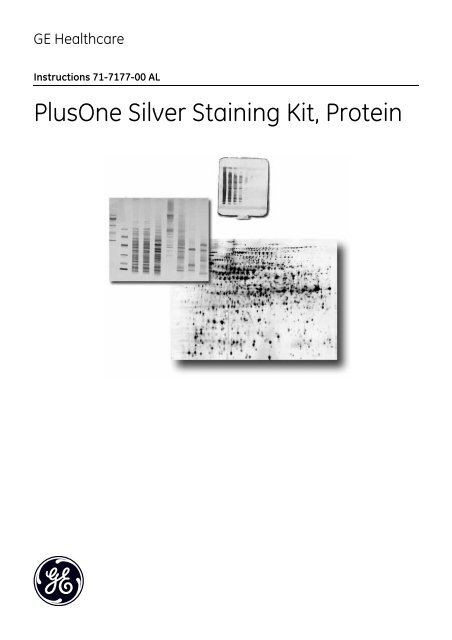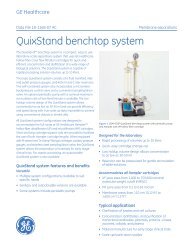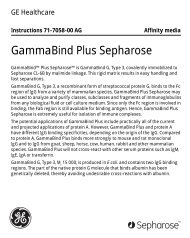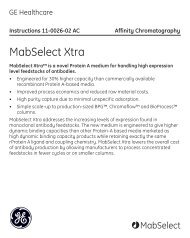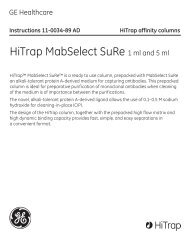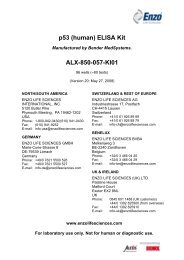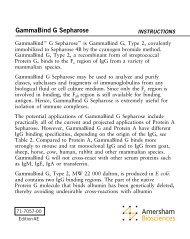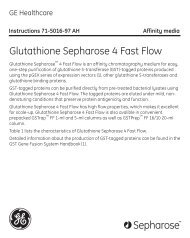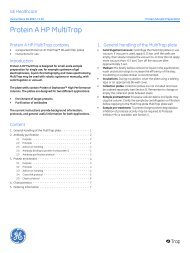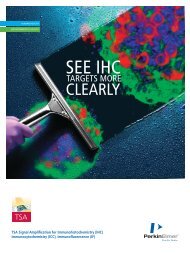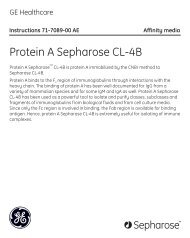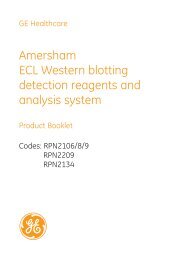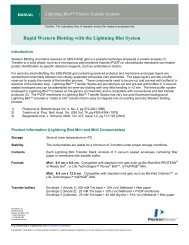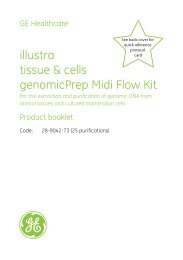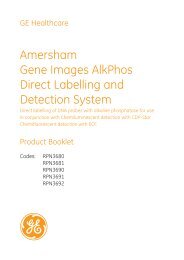PlusOne Silver Staining Kit, Protein - GE Healthcare Life Sciences
PlusOne Silver Staining Kit, Protein - GE Healthcare Life Sciences
PlusOne Silver Staining Kit, Protein - GE Healthcare Life Sciences
Create successful ePaper yourself
Turn your PDF publications into a flip-book with our unique Google optimized e-Paper software.
<strong>Staining</strong> procedureAll steps should be performed with gentle shaking of the staining tray.1 Fixation: 30 min.Soak the gel in fixing solution for 30 minutes.2 Sensitizing: 30 min.Remove the solution. Add sensitizing solution and leave shaking for at least 30 minutes.3 Washing: 3 x 5 min.Remove the sensitizing solution. Add distilled water and wash three times for 5 minuteseach time.4 <strong>Silver</strong> reaction: 20 min.Add silver solution and leave shaking for 20 minutes.5 Washing: 2 x 1 min.Remove the silver solution. Rinse twice in distilled water for one minute each time.6 Developing: 2 to 5 min.Add developing solution and leave shaking for 2 to 5 minutes. Transfer the gel tostopping solution when the bands / spots have reached desired intensity.7 Stopping: 10 min.Leave gel shaking in stopping solution for 10 minutes.8 Washing: 3 x 5 min.Remove the stop solution. Add distilled water and wash three times for 5 minutes eachtime.9 Preserving:20 min. (plastic-backed gels)2 x 30 min. (gels not supported on plastic films)Add preserving solution and leave shaking for 20 minutes for plastic backed gels. Forgels not supported on plastic films, shake for 30 minutes, pour off the solution, addfresh and shake for a further 30 minutes.10 Drying: OvernightPut the gel on a glass plate and wrap it in Cellophane sheet. Leave the gel to dryovernight at room temperature. Do not put the gel in a heating cabinet (the silver stainbleaches at elevated temperatures).Instructions 71-7177-00 AL 7
BCleanGel IEF and Immobiline DryPlateChemicals required• Chemicals included in this <strong>PlusOne</strong> <strong>Silver</strong> <strong>Staining</strong> <strong>Kit</strong>, <strong>Protein</strong>• Ethanol• Trichloroacetic acid (TCA)• Glycerol (87% w/w) (1000 ml) (Code No. 17-1325-01)ReagentsMake up the following reagent solutions using the chemicals listed above.250 ml solution is needed per gel and step.Note: Glutardialdehyde and formaldehyde should be added immediately before use.Reagent nameFixing solution TCASensitizing solution<strong>Silver</strong> solutionDeveloping solutionStop solutionWashing solutionPreserving solutionComponent and quantityTrichloroacetic acid 50 gWater to 250 mlEthanol 75 mlSodium thiosulphate (5% w/v) 10 mlSodium acetate (17 g) 1 packetWater to 250 mlBefore use: Add 1.25 ml glutardialdehyde (25% w/v)<strong>Silver</strong> nitrate solution (2.5% w/v) 25 mlWater to 250 mlSodium carbonate (6.25 g) 1 packetWater to 250 mlStir vigorously to dissolve the sodium carbonateBefore use: Add 0.2 ml formaldehyde (37% w/v)EDTA-Na 2 •2H 2 O (3.65 g) 1 packetWater to 250 mlWaterGlycerol (87% w/w) 25 mlWater to 250 ml8 Instructions 71-7177-00 AL
<strong>Staining</strong> procedure1 Fixation: 30 min.Soak the gel in fixing solution for 30 minutes.2 Washing: 3 x 5 min.Wash the gel three times in distilled water for 5 minutes each time.3 Sensitizing: 30 min.Remove the solution. Add sensitizing solution and leave shaking for at least 30 minutes.4 Washing: 3 x 10 min.Remove the sensitizing solution. Add distilled water and wash 3 times for 10 minuteseach time.5 <strong>Silver</strong> reaction: 20 min.Add silver solution and leave shaking for 20 minutes.6 Washing: 2 x 1 min.Remove the silver solution. Rinse twice in distilled water for one minute each time.7 Developing: 2 to 5 min.Add developing solution and leave shaking for 2 to 5 minutes. Transfer the gel tostopping solution when the bands / spots have reached desired intensity.8 Stopping: 10 min.Leave gels shaking in stopping solution for 10 minutes.9 Washing: 3 x 5 min.Remove the stop solution. Add distilled water and wash three times for 5 minutes eachtime.10 Preserving: 20 min.Add preserving solution and leave shaking for 20 minutes.11 Drying: OvernightPut the gel on a glass plate and wrap it in Cellophane Sheet. Leave the gel to dryovernight at room temperature. Do not put the gel in a heating cabinet (the silver stainbleaches at elevated temperatures).Instructions 71-7177-00 AL 9
CEttan DALT 12.5 Precast gel and conventional slab gels 1.5 mmFor staining large scale gels we recommend using the <strong>Staining</strong> Tray Set (see Section5.2 Chemicals and accessories).Chemicals required• Chemicals included in this <strong>PlusOne</strong> <strong>Silver</strong> <strong>Staining</strong> <strong>Kit</strong>, <strong>Protein</strong>• Ethanol• Glacial acetic acid• GlycerolReagentsMake up the following reagent solutions using the chemicals listed above.250 ml solution is needed per gel and step.Note: Glutardialdehyde and formaldehyde should be added immediately before use.Reagent nameFixing solution 30% EthanolSensitizing solution<strong>Silver</strong> solutionDeveloping solutionStop solutionWashing solutionPreserving solutionComponent and quantityEthanol 75 mlGlacial acetic acid 25 mlWater to 250 mlEthanol 75 mlSodium thiosulphate (5% w/v) 10 mlSodium acetate (17 g) 1 packetWater to 250 mlBefore use: Add 1.25 ml glutardialdehyde (25% w/v)<strong>Silver</strong> nitrate solution (2.5% w/v) 25 mlWater to 250 mlSodium carbonate (6.25 g) 1 packetWater to 250 mlStir vigorously to dissolve the sodium carbonateBefore use: Add 0.2 ml formaldehyde (37% w/v)EDTA-Na 2 •2H 2 O (3.65 g) 1 packetWater to 250 mlWaterGlycerol (87% w/w) 25 mlWater to 250 ml10 Instructions 71-7177-00 AL
<strong>Staining</strong> procedureAll steps should be performed with gentle shaking of the staining tray.1 Fixation: 120 min.Soak the gel in fixing solution for 120 minutes (or over night).2 Sensitizing: 120 min.Remove the solution. Add sensitizing solution and leave shaking for 120 minutes.3 Washing: 5 x 15 min.Remove the sensitizing solution. Add distilled water and wash five times for 15 minuteseach time.4 <strong>Silver</strong> reaction: 120 min.Add silver solution and leave shaking for 120 minutes.5 Washing: 2 x 1 min.Remove the silver solution. Wash twice in distilled water for one minute each time.6 Developing: 4 to 6 min.Add developing solution and leave shaking for 4 to 6 minutes. Transfer the gel tostopping solution when the bands / spots have reached desired intensity.7 Stopping: 120 min.Leave shaking for 120 minutes.8 Preserving: 120 min.Add preserving solution and leave shaking for 120 minutes.9 Drying: OvernightUse the Easy Breeze air gel drying system gel frames to put the gel between wetcellophane sheets (see Section 5.2 Chemicals and accessories). Leave the gel to dryovernight at room temperature. Do not put the gel in a heating cabinet (the silver stainbleaches at elevated temperatures).Instructions 71-7177-00 AL 11
DConventional slab gels 1 mmFor staining large scale gels we recommend using the <strong>Staining</strong> Tray Set (see Section5.2 Chemicals and accessories).Chemicals required• Chemicals included in this <strong>PlusOne</strong> <strong>Silver</strong> <strong>Staining</strong> <strong>Kit</strong>, <strong>Protein</strong>• Ethanol• Glacial acetic acid• Glycerol (87% w/w) (1000 ml) (Code No. 17-1325-01)ReagentsMake up the following reagent solutions using the chemicals listed above.250 ml solution is needed per gel and step.Note: Glutardialdehyde and formaldehyde should be added immediately before use.Reagent nameFixing solution 30% EthanolSensitizing solution<strong>Silver</strong> solutionDeveloping solutionStop solutionWashing solutionPreserving solutionComponent and quantityEthanol 75 mlGlacial acetic acid 25 mlWater to 250 mlEthanol 75 mlSodium thiosulphate (5% w/v) 10 mlSodium acetate (17 g) 1 packetWater to 250 mlBefore use: Add 1.25 ml glutardialdehyde (25% w/v)<strong>Silver</strong> nitrate solution (2.5% w/v) 25 mlWater to 250 mlSodium carbonate (6.25 g) 1 packetWater to 250 mlStir vigorously to dissolve the sodium carbonateBefore use: Add 0.2 ml formaldehyde (37% w/v)EDTA-Na 2 •2H 2 O (3.65 g) 1 packetWater to 250 mlWaterEthanol 75 mlGlycerol (87% w/w) 11.5 mlWater to 250 ml12 Instructions 71-7177-00 AL
<strong>Staining</strong> procedureAll steps should be performed with gentle shaking of the staining tray.1 Fixation: 60 min.Soak the gel in fixing solution for 60 minutes (or up to 24 hours).2 Sensitizing: 60 min.Remove the solution. Add sensitizing solution and leave shaking for 60 minutes (or upto 24 hours).3 Washing: 4 x 15 min.Remove the sensitizing solution. Add distilled water and wash four times for 15 minuteseach time.4 <strong>Silver</strong> reaction: 60 min.Add silver solution and leave shaking for 60 minutes.5 Washing: 2 x 1 min.Remove the silver solution. Wash twice in distilled water for one minute each time.6 Developing: 4 to 6 min.Add developing solution and leave shaking for 4 to 6 minutes. Transfer the gel tostopping solution when the bands / spots have reached desired intensity.7 Stopping: 60 min.Leave shaking for 60 minutes.8 Preserving: 60 min.Add preserving solution and leave shaking for 60 minutes.9 Drying: OvernightUse the Easy Breeze air gel drying system gel frames to put the gel between wetcellophane sheets (see Section 5.2 Chemicals and accessories). Leave the gel to dryovernight at room temperature. Do not put the gel in a heating cabinet (the silver stainbleaches at elevated temperatures).Instructions 71-7177-00 AL 13
EEttan DALT 12.5 Precast gel / In-house cast 1 mm gel on glassbacking (Bind-Silane treated), MS compatibleFor staining large scale gels we recommend using the <strong>Staining</strong> Tray Set (see Section5.2 Chemicals and accessories).Chemicals required• Chemicals included in this <strong>PlusOne</strong> <strong>Silver</strong> <strong>Staining</strong> <strong>Kit</strong>, <strong>Protein</strong>• Ethanol• Glacial acetic acidReagentsMake up the following reagent solutions using the chemicals listed above.500 ml solution is needed per gel and step.Note: Formaldehyde should be added to the developing solution immediately before use.By omitting the glutardialdehyde from the sensitizer and formaldehyde from thesilver solution the method becomes compatible with mass spectrometry analysis,however at the expense of sensitivity (10 ng).Reagent nameFixing solution 30% EthanolSensitizing solution<strong>Silver</strong> solutionDeveloping solutionStop solutionWashing solutionComponent and quantityEthanol 150 mlGlacial acetic acid 50 mlWater to 500 mlEthanol 75 mlSodium thiosulphate (5% w/v) 10 mlSodium acetate (17 g) 1 packetWater to 250 ml<strong>Silver</strong> nitrate solution (2.5% w/v) 25 mlWater to 250 mlSodium carbonate (6.25 g) 1 packetWater to 250 mlStir vigorously to dissolve the sodium carbonateBefore use: Add 0.2 ml formaldehyde (37% w/v)EDTA-Na 2 •2H 2 O (3.65 g) 1 packetWater to 250 mlWater14 Instructions 71-7177-00 AL
<strong>Staining</strong> procedureAll steps should be performed with gentle shaking of the staining tray.1 Fixation: 2 x 60 min.Soak the gel in fixing solution for 60 minutes. Repeat step once.2 Sensitizing: 120 min.Remove the solution. Add sensitizing solution and leave shaking for 120 minutes.3 Washing: 5 x 8 min.Remove the sensitizing solution. Add distilled water and wash five times for 8 minuteseach time.4 <strong>Silver</strong> reaction: 60 min.Add silver solution and leave shaking for 60 minutes.5 Washing: 4 x 1 min.Remove the silver solution. Wash four times in distilled water for one minute each time.6 Developing: 2 to 5 min.Add developing solution and leave shaking for 2 to 5 minutes. Transfer the gel tostopping solution when the bands / spots have reached desired intensity.7 Stopping: 45 min.Leave shaking for 45 minutes.8 Washing: 2 x 30 min.Remove the stop solution. Add distilled water and wash two times for 30 minutes eachtime.9 Storing: WaterUse water for up to one week and 5% acetic acid for longer periods.Instructions 71-7177-00 AL 15
FProtocol for PhastGel SDS mediaChemicals required• Chemicals included in this <strong>PlusOne</strong> <strong>Silver</strong> <strong>Staining</strong> <strong>Kit</strong>, <strong>Protein</strong>• Ethanol• Glacial acetic acid• Glycerol (87% w/w) (1000 ml) (Code No. 17-1325-01)ReagentsMake up the following reagent solutions using the chemicals listed above.80 ml solution is needed per 1 to 2 gels and step.Note: Glutardialdehyde and formaldehyde should be added immediately before use.Reagent nameFixing solution 30% EthanolSensitizing solution<strong>Silver</strong> solutionDeveloping solutionStop solutionWashing solutionPreserving solutionComponent and quantityEthanol 75 mlGlacial acetic acid 25 mlWater to 250 mlEthanol 75 mlSodium thiosulphate (5% w/v) 10 mlSodium acetate (17 g) 1 packetWater to 250 mlBefore use: Add 0.4 ml glutardialdehyde (25% w/v) to 80ml of the sensitizing solution<strong>Silver</strong> nitrate solution (2.5% w/v) 25 mlWater to 250 mlSodium carbonate (6.25 g) 1 packetWater to 250 mlStir vigorously to dissolve the sodium carbonateBefore use: Add 0.05 ml formaldehyde (37% w/v) to 80 mldeveloping solutionEDTA-Na 2 •2H 2 O (3.65 g) 1 packetWater to 250 mlWaterGlycerol (87% w/w) 25 mlWater to 250 ml16 Instructions 71-7177-00 AL
<strong>Staining</strong> procedureSteps to be programmed into the development method file:.StepTime TempSolution IN OUT (min.) (°C)1 Fixing solution 30% Ethanol 2 0 10 502 Sensitizing solution 3 9 1 10 503 Water 4 0 4 504 Water 4 0 4 505 Water 4 0 4 506 Water 4 0 4 407 <strong>Silver</strong> solution 5 9 1 10 408 Water 4 0 1 209 Water 4 0 1 2010 Developing solution 6 9 1 1 to 5 2 2011 Stop solution 7 0 10 5012 Preserving solution 8 0 10 5012Please consult local regulations for information on proper disposalGuideline only, need to be optimizedInstructions 71-7177-00 AL 17
GProtocol for PhastGel Native media• Chemicals required• Chemicals included in this <strong>PlusOne</strong> <strong>Silver</strong> <strong>Staining</strong> <strong>Kit</strong>, <strong>Protein</strong>• Ethanol• Trichloroacetic acid (TCA)• Glacial acetic acid• Glycerol (87% w/w) (1000 ml) (Code No. 17-1325-01)ReagentsMake up the following reagent solutions using the chemicals listed above.80 ml solution is needed per 1 to 2 gels and step.Note: Glutardialdehyde and formaldehyde should be added immediately before use.Reagent nameFixing solution TCAFixing solution 30% EthanolSensitizing solution<strong>Silver</strong> solutionDeveloping solutionStop solutionWashing solutionPreserving solutionComponent and quantityTrichloroacetic acid 50 gWater to 250 mlEthanol 75 mlGlacial acetic acid 10 mlWater to 250 mlEthanol 75 mlSodium thiosulphate (5% w/v) 10 mlSodium acetate (17 g) 1 packetWater to 250 mlBefore use: Add 0.4 ml glutardialdehyde (25% w/v) to 80ml of the sensitizing solution<strong>Silver</strong> nitrate solution (2.5% w/v) 50 mlWater to 250 mlSodium carbonate (6.25 g) 1 packetWater to 250 mlStir vigorously to dissolve the sodium carbonateBefore use: Add 0.05 ml formaldehyde (37% w/v) to 80 mlof the developing solutionEDTA-Na 2 •2H 2 O (3.65 g) 1 packetWater to 250 mlWaterGlycerol (87% w/w) 25 mlWater to 250 ml18 Instructions 71-7177-00 AL
<strong>Staining</strong> procedureSteps to be programmed into the development method file:.StepTime TempSolution IN OUT (min.) (°C)1 Fixing solution TCA 1 9 1 10 202 Fixing solution 30% Ethanol 2 0 5 503 Sensitizing solution 3 9 1 10 504 Water 4 0 4 505 Water 4 0 4 506 Water 4 0 4 507 Water 4 0 4 508 Water 4 0 4 409 <strong>Silver</strong> solution 5 9 1 10 4010 Water 4 0 1 2011 Water 4 0 1 2012 Developing solution 6 9 1 1 to 5 2 2013 Stop solution 7 0 10 5014 Preserving solution 8 0 10 501 Please consult local regulations for information on proper disposal2 Guideline only, need to be optimizedInstructions 71-7177-00 AL 19
HProtocol for PhastGel IEF mediaChemicals required• Chemicals included in this <strong>PlusOne</strong> <strong>Silver</strong> <strong>Staining</strong> <strong>Kit</strong>, <strong>Protein</strong>• Ethanol• Trichloroacetic acid (TCA)• Glacial acetic acid (HAc)• Glycerol (87% w/w) (1000 ml) (Code No. 17-1325-01)ReagentsMake up the following reagent solutions using the chemicals listed above.80 ml solution is needed per 1 to 2 gels and step.Note: Glutardialdehyde and formaldehyde should be added immediately before use.Preserving solution is not necessary for Phast IEF media.Reagent nameFixing solution TCAFixing solution 10% EthanolSensitizing solution<strong>Silver</strong> solutionDeveloping solutionStop solutionWashing solutionComponent and quantityTrichloroacetic acid 50 gWater to 250 mlEthanol 50 mlGlacial acetic acid 25 mlWater to 500 mlEthanol 75 mlSodium thiosulphate (5% w/v) 10 mlSodium acetate (17 g) 1 packetWater to 250 mlBefore use: Add 0.4 ml glutardialdehyde (25% w/v) to80 ml of the sensitizing solution<strong>Silver</strong> nitrate solution (2.5% w/v) 25 mlWater to 250 mlSodium carbonate (6.25 g) 1 packetWater to 250 mlStir vigorously to dissolve the sodium carbonateBefore use: Add 0.05 ml formaldehyde (37% w/v) to 80 mlof the developing solutionGlacial acetic acid 12.5 mlWater to 250 mlWater20 Instructions 71-7177-00 AL
<strong>Staining</strong> procedureSteps to be programmed into the development method file:.StepTime TempSolution IN OUT (min.) (°C)1 Fixing solution TCA 1 9 1 5 202 Fixing solution 10% Ethanol 2 0 4 503 Fixing solution 10% Ethanol 2 0 4 504 Sensitizing solution 3 9 1 6 505 Fixing solution 10% Ethanol 2 0 3 506 Fixing solution 10% Ethanol 2 0 5 507 Water 4 0 2 508 Water 4 0 2 509 <strong>Silver</strong> solution 5 9 1 10 4010 Water 4 0 0.5 2011 Water 4 0 0.5 2012 Developing solution 6 9 1 1 to 5 2 2013 Stop solution 7 0 10 5012Please consult local regulations for information on proper disposalGuideline only, need to be optimizedInstructions 71-7177-00 AL 21
4 Troubleshooting guideProblem Cause RemedyBands / spots do not develop Temperature of solution too low Keep temperature of solutionbetween 5 and 25 °CGel not washed thoroughlyenoughRepeat washing procedureBackground is excessively dark(over-developed)Bands lighter than thebackgroundSmearing or blackening in laneswhere protein loadedDid not fix properlyTemperature of developingsolution too highWater impureThe carrier ampholytes have notbeen washed outOverloadingOverloadingCheck fixing solution or fixingproperties of your particularprotein(s)Chill the developing solution inthe refrigerator before useUse deionized water whenevercontaminated possibleAfter stop solution step, put thegel in 1% sodium thiosulphatesolution for several hours toreduce the silver stainLower the amount of proteinloaded onto the gelDilute samples (remember silverstaining is approximately 50 to100 times more sensitive thanCoomassie Blue)<strong>Silver</strong> mirror reaction Insufficient washing with water Extend the time of washing afterstainingDirty trayReplace the chamber fordevelopment with a new cleanoneInsufficient shakingDuring the development stepshake the tray sufficiently toprevent the gel from sticking tothe bottom of the tray22 Instructions 71-7177-00 AL
5 Ordering information5.1 <strong>PlusOne</strong> <strong>Silver</strong> <strong>Staining</strong> <strong>Kit</strong>, <strong>Protein</strong>ProductCode No.<strong>PlusOne</strong> <strong>Silver</strong> <strong>Staining</strong> <strong>Kit</strong>, <strong>Protein</strong> 17-1150-015.2 Chemicals and accessoriesChemicalsCode No.<strong>PlusOne</strong> Glycerol 17-1325-01<strong>PlusOne</strong> Urea 17-1319-01<strong>PlusOne</strong> IodoacetamideRPN6302<strong>PlusOne</strong> CHAPS 17-1314-01<strong>PlusOne</strong> Triton X-100 17-1315-01<strong>PlusOne</strong> Acrylamide PA<strong>GE</strong> 17-1303-01<strong>PlusOne</strong> N,N'-Methylene-bisacryalmide 17-1306-01<strong>PlusOne</strong> Ammonium Persulphate 17-1311-01<strong>PlusOne</strong> TEMED 17-1312-01<strong>PlusOne</strong> Bind-Silane (25 ml) 17-1330-01<strong>PlusOne</strong> Tris 17-1321-01<strong>PlusOne</strong> Glycine 17-1323-01<strong>PlusOne</strong> Tween 20 17-1316-01<strong>PlusOne</strong> SDS 17-1313-01<strong>PlusOne</strong> DTT 17-1318-01<strong>PlusOne</strong> Bromophenol blue (BFB) 17-1329-012D Quant <strong>Kit</strong> 80-6483-56DeStreak Rehydration Solution 17-6003-19DeStreak Reagent 17-6003-18AccessoriesCode No.<strong>Staining</strong> Tray Set 80-6468-17Cellophane Sheets 80-1129-38Gel frame, large (up to 21 × 26 cm gels) 80-6429-22Gel loading platform large80-6429-41(works with 80-6429-22)Instructions 71-7177-00 AL 23
5.3 Precast gels and related productsMolecular weight and pI markersProductCode No.Peptide Marker <strong>Kit</strong> (MW range 2 512 to 16 949) 80-1129-83LMW-SDS Marker <strong>Kit</strong> (MW range 14 000 to 97 000) 17-0446-01HMW-SDS Marker <strong>Kit</strong> (MW range 53 000 to 220 000) 17-0615-01HMW Native Marker <strong>Kit</strong> (MW range 66 000 to 669 000) 17-0445-01Broad pI <strong>Kit</strong> pH 3 to 10 17-0471-01Low pI <strong>Kit</strong> pH 2.5 to 6.5 17-0472-01High pI <strong>Kit</strong> pH 5 to 10.5 17-0473-01Precast gels and buffer strips for SDS PA<strong>GE</strong>, IEF and Native PA<strong>GE</strong>ProductCode No.ExcelGel SDS Homogeneous 7.5 80-1260-01ExcelGel SDS Homogeneous 12.5 80-1261-01ExcelGel SDS Homogeneous 15 80-1262-01ExcelGel SDS, gradient 8-18 80-1255-53ExcelGel XL SDS 12-14 17-1236-01ExcelGel SDS Buffer Strips 17-1342-01CleanGel IEF 18-1031-54Immobiline DryPlate pH 4.0 to 7.0 80-1128-28Immobiline DryPlate pH 4.2 to 4.9 80-1128-29Immobiline DryPlate pH 4.5 to 5.4 80-1128-30Immobiline DryPlate pH 5.0 to 6.0 80-1128-31Immobiline DryPlate pH 5.6 to 6.6 80-1128-32PhastGel Gradient 4 to 15 17-0678-01PhastGel Gradient 10 to 15 17-0678-01PhastGel Gradient 8 to 25 17-0542-01PhastGel Homogeneous 7.5 17-0622-01PhastGel Homogeneous 12.5 17-0623-01PhastGel Homogeneous 20 17-0624-01PhastGel Homogeneous High Density 17-0679-01PhastGel IEF - 3 to 9 17-0543-01PhastGel IEF - 4 to 6.5 17-0544-01PhastGel IEF - 5 to 8 17-0545-01PhastGel Dry 17-0677-01PhastGel Buffer StripsSDS17-0516-01PhastGel Buffer Strips Native 17-0517-0124 Instructions 71-7177-00 AL
2-D, First dimensionImmobilineDryStrip, 7 cmCode No.ImmobilineDryStrip, 11 cmCode No.pH 3 to 5.6 NL 17-6003-53 pH 3 to 5.6 NL 17-6003-54pH 5.3 to 6.5 17-6003-58 pH 5.3 to 6.5 17-6003-59pH 6.2 to 7.5 17-6003-63 pH 6.2 to 7.5 17-6003-64pH 7 to 11 NL 17-6003-68 pH 7 to 11 NL 17-6003-69pH 3 to 11 NL 17-6003-73 pH 3 to 11 NL 17-6003-74pH 4 to 7 17-6001-10 pH 4 to 7 18-1016-60pH 3 to 10 17-6001-11 pH 3 to 10 18-1016-61pH 3 to 10 NL 17-6001-12 pH 6 to 11 17-6001-95pH 6 to 11 17-6001-94ImmobilineDryStrip, 13 cmCode No.ImmobilineDryStrip, 18 cmCode No.pH 3 to 5.6 NL 17-6003-55 pH 3 to 5.6 NL 17-6003-56pH 5.3 to 6.5 17-6003-60 pH 5.3 to 6.5 17-6003-61pH 6.2 to 7.5 17-6003-65 pH 6.2 to 7.5 17-6003-66pH 7 to 11 NL 17-6003-70 pH 7 to 11 NL 17-6003-71pH 3 to 11 NL 17-6003-75 pH 3 to 11 NL 17-6003-76pH 4 to 7 17-6001-13 pH 4 to 7 17-1233-01pH 3 to 10 17-6001-14 pH 3 to 10 17-1234-01pH 3 to 10 NL 17-6001-15 pH 3 to 10 NL 17-1235-01pH 6 to 11 17-6001-96 pH 3.5 to 4.5 17-6001-83pH 4.0 to 5.0 17-6001-84pH 4.5 to 5.5 17-6001-85pH 5.0 to 6.0 17-6001-86pH 5.5 to 6.7 17-6001-87pH 6 to 9 17-6001-88pH 6 to 11 17-6001-97Instructions 71-7177-00 AL 25
ImmobilineDryStrip, 24 cm2-D, Second dimensionCode No. IPG buffers Code No.pH 3 to 5.6 NL 17-6003-57 IPG Buffer pH 3.5 to 5.0 17-6002-02pH 5.3 to 6.5 17-6003-62 IPG Buffer pH 4.5 to 5.5 17-6002-04pH 6.2 to 7.5 17-6003-67 IPG Buffer pH 5.0 to 6.0 17-6002-05pH 7 to 11 NL 17-6003-72 IPG Buffer pH 5.5 to 6.7 17-6002-06pH 3 to 11 NL 17-6003-77 IPG Buffer pH 4 to 7 17-6000-86pH 3.5 to 4.5 17-6002-38 IPG Buffer pH 6 to 11 17-6001-78pH 4.0 to 5.0 17-6002-39 IPG Buffer pH 7 to 11 NL 17-6004-39pH 4.5 to 5.5 17-6002-40 IPG Buffer pH 3 to 10 NL 17-6000-88pH 5.0 to 6.0 17-6002-41 IPG Buffer pH 3 to 10 17-6000-87pH 5.5 to 6.7 17-6002-42 IPG Buffer pH 3 to 11 NL 17-6004-40pH 3 to 7 NL 17-6002-43pH 3 to 10 17-6002-44pH 3 to 10 NL 17-6002-45pH 4 to 7 17-6002-46pH 6 to 9 17-6001-88ProductCode No.ExcelGel SDS, gradient 8-18 80-1255-53ExcelGel XL SDS 12-14 17-1236-01ExcelGel SDS Buffer Strips 17-1342-01DALT Gel 12.5 17-6002-36DALT Gel Buffer <strong>Kit</strong> 17-6002-365.4 Electrophoresis equipmentProductCode No.Ettan DALT Twelve Separation Unit 80-6466-46Ettan DALTsix Large Vertical System 80-6485-08SE 600 Ruby Vertical Unit 80-6479-57SE 400 Vertical Unit 80-6155-24Multiphor II Electrophoresis System 18-1018-06MultiTemp III Thermostatic Circulator 18-1102-78PhastSystem 18-1018-23miniVE Vertical Electrophoresis System 80-6418-77Mini-Vertical Units 80-6147-4526 Instructions 71-7177-00 AL
Instructions 71-7177-00 AL 27
For contact information for yourlocal office, please visitwww.gelifesciences.com/contact<strong>GE</strong> <strong>Healthcare</strong> Bio-<strong>Sciences</strong> ABBjörkgatan 30751 84 UppsalaSwedenwww.gelifesciences.com<strong>GE</strong> tagline and <strong>GE</strong> monogram are trademarks of General ElectricCompany.Ampholine, CleanGel, DeStreak, Ettan, ExcelGel, Immobiline,Multiphor, MultiTemp, PhastGel and PhastSystem are trademarks of<strong>GE</strong> <strong>Healthcare</strong> companies.All third party trademarks are the property of their respective owners.© 1993-2008 General Electric Company – All rights reserved.First published Oct. 1993.All goods and services are sold subject to the terms and conditions ofsale of the company within <strong>GE</strong> <strong>Healthcare</strong> which supplies them. Acopy of these terms and conditions is availableon request. Contactyour local <strong>GE</strong> <strong>Healthcare</strong> representative for the most currentinformation.<strong>GE</strong> <strong>Healthcare</strong> UK LtdAmersham Place, Little Chalfont, Buckinghamshire, HP7 9NA, UK<strong>GE</strong> <strong>Healthcare</strong> Bio-<strong>Sciences</strong> Corp800 Centennial Avenue, P.O. Box 1327, Piscataway, NJ 08855-1327,USA<strong>GE</strong> <strong>Healthcare</strong> Europe GmbHMunzinger Strasse 5, D-79111 Freiburg, Germany<strong>GE</strong> <strong>Healthcare</strong> Bio-<strong>Sciences</strong> KKSanken Bldg. 3-25-1, Hyakunincho, Shinjuku-ku, Tokyo 169-0073,Japanimagination at work71-7177-00 AL 09/2008


